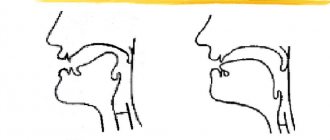When parents notice a speech defect such as burr in their children, they begin to take their children to speech therapists and take various measures to eliminate incorrect pronunciation. But there are people who deliberately want to know how to learn to burr. One of the main reasons for this desire is to study French. Also, many young people want to imitate their idols (for example, the leader of the group “Okean Elzy” Svyatoslav Vakarchuk, the rap artist “Guf” and many others are known for their incorrect pronunciation of this sound).
Etiology of speech disorder
When pronouncing “R” correctly, the tongue should rise to the palate near the front teeth. This is how vibration appears, which gives this sound. Problems with “R” in adults begin in childhood. The main causes of burr are:
- injuries – defect of the tip or frenulum;
- cervical spine injuries;
- hypoxia during childbirth;
- hydrocephalus;
- intracranial pressure;
- hearing aid disorders;
- inflammatory changes in the hearing aid;
- congenital hearing loss;
- pathologies of phonetic hearing;
- poor bite or missing teeth;
- short bridle;
- paralysis, paresis;
- palate pathologies;
- speech or mental development delays;
- "cleft" lip;
Another reason is the development of a child surrounded by people with impaired hearing and speech. So, from early childhood, the baby hears and gets used to incorrect pronunciation. Burr is not a serious speech therapy disorder; with the help of a course of speech therapy assistance, it is completely corrected.
Thus, four main groups of causes of rotacism can be distinguished:
- Mechanical. Pathologies of the structure of the articulatory apparatus.
- Imitative. The child copies the incorrect pronunciation from the parents.
- Acoustic. Incorrect phonetic perception of the sound “R”.
- Neurological. Pathologies of the speech departments of the human brain.
Before a speech therapist develops a course on how to get rid of burr, it is necessary to accurately determine the cause of its development or appearance.
Studying sayings and tongue twisters
To learn and consolidate the skill of pronunciation of the grazing sound “R”, it is good to use sayings and tongue twisters in French. Finding them is not difficult; there are a huge number of them on the Internet.
Having chosen short and simple expressions to begin with, you can begin to pronounce them. Before doing this, it is better to listen to how the French themselves do it. Over time, you can move on to longer and more complex phrases. For example, you can take the following tongue twister:
"Rat vit riz Rat mit patte à ras Rat mit patte à riz Riz ciut patte à rat."
You can also use this example of a saying:
"Dans la gendarmerie, quand un gendarme rit, tous les gendarmes rient dans la gendarmerie."
You can also find out how to pronounce these expressions on the global network. If a person can master the correct pronunciation of tongue twisters and sayings, then all the work was not in vain. After all, their reproduction is not so simple.
Types of burr
There are different types of rotacism. Depending on its etiology, there are two types:
- Velar. The vibration occurs at the edge of the soft palate.
- Uvular rotacism. The vibration occurs on the small uvula of the soft palate.
In a broad sense, there are several forms of burr (rhotacism):
- Simple or monomorphic. The pronunciation of one or more sounds of one group is impaired - “S Z C”, “ZH Sh Ch”.
- Polymorphic or complex. The articulation of phonemes from different groups is impaired.
- Physiological. Also called age-related. With it, sound pronunciation is impaired in children under five years of age, which is associated with insufficient development of articulatory organs.
- Functional. Rotacism develops in the absence of problems with the articulatory apparatus, central nervous system, hearing and other devices and systems.
- Mechanical or organic. The development of rhotacism is associated with congenital or acquired pathologies of the speech apparatus.
An accurate diagnosis can only be made by a speech therapist. The definition of burr determines the choice of methods for its correction.
Rotacisms
Correction of burr in adults and children depends on the form of rhotacism. They are as follows:
- There is no “R” in the speech (handle - uchka, river - eka);
- Velar rhotacism or soft pronunciation. The root of the tongue comes into contact with the soft palate, namely its lower edge. A stream of air passes through the gap between them during pronunciation, causing the palate to vibrate.
- Uvular rotacism. Often called "throat".
- Side. The vibration occurs on the side of the tongue, not on the tip. This is how a sound similar to “l” or “rl” appears.
- Bilabial. This type is also called labial, labial or bilabial. Distortion occurs when the lips vibrate, this is how it turns out “prr”. Speech therapists call this sound a coachman's sound.
- Interdental or interdental. Sound pronunciation is caused by the position of the tongue between the teeth.
- Single-strike or proto. Reminds me of “d”, it’s impossible to pronounce the long “RRRRRRRR”.
- Buccal. The exhaled air passes between the cheeks, which causes vibration.
- Nasal. The root is in contact with the soft palate, and air passes through the nose.
- replacing “P” hard with soft.
- Labiodental. The sound is formed between the lip and the upper teeth.
- Laryngeal or laryngeal.
Depending on the form of rotacism, certain exercises are selected aimed at correcting this phenomenon.
Pararotacisms
Pararotacism is the replacement of the rumbling “R” sound with a softer one. The main causes are paresis, short frenulum, impaired phonetic hearing and copying incorrect pronunciation from adults. With pararotacism, the following “P” substitutions occur:
- c: appears in the absence of vibration - “wuka - hand”;
- d: it turns out “hand - duka”;
- g: “hand – guka”;
- n: hand – puka;
- l: hand - bow;
- s: hand – yuka;
- y: hand – yuka.
Correction of pararotacism has many similar sections to burr. The most basic exercise for this is tongue twisters for burr.
Functional burr
Functional burr can develop in a child due to chronic diseases. Another common reason is pedagogical neglect - when a child is given insufficient time from parents and adults, the child develops slowly, not because he has problems with the intellect, but because no one works with him or they do not do it enough.
Often this phenomenon develops in children from bilingual families, that is, adults speak different languages, or from families where one or both parents have such problems. In this way, the child copies the pronunciation of adults. Also, this type of burr may appear due to the presence of disorders of the articulatory apparatus or underdeveloped phonetic hearing.
Organic burr
Occurs due to the structural features of the oral cavity - teeth, bite, tongue (frenulum). A child or adult may burr due to improper jaw structure or lack of teeth. In this case, it is impossible to get rid of rotacism without the help of dentists and an orthodontist. The organic form can appear during life as a result of trauma.
Sensory tongue-tiedness (dyslalia)
This speech disorder is also called tongue-tied or dyslalia. This consists of the inability to pronounce certain sounds or series of sounds. Tongue-tied sounds can be all vowels or all consonants. In the simplest cases, tongue-tiedness affects one or more. Such phonemes are sometimes dropped out or replaced by others. Tongue-tiedness can be called the most common speech defect in a child.
Functional tongue-tiedness is a consequence of improper speech development. It usually occurs at 3-4 years of age and can continue into preschool age. Cases of tongue-tiedness in adults are rare, but they do exist.
How to learn to burr R
If a person began to burr in childhood, this does not mean at all that he is sick, there is no need to run to the doctors, everything can be solved.
Likewise, with the desire to develop burr for any personal purposes, follow the recommendations and training. When speaking Russian using this sound, use the tip of your tongue. When pronouncing the letter P, understand the position in which your tongue is fixed. Then, try a little, moving the vibrations from the tip to its base. If your attempts are unsuccessful, try speaking in the Ukrainian style with the sound G, increasing the strength of the vibration over time. One of the effective recommendations for mastering the correct R sound is to listen to more audio in French. Here it is possible to include music, news, films. First, listen a couple of times, then try to duplicate it, carefully monitoring your literacy and similarity of pronunciation. And to check that you have achieved the desired result after actions, record your pronunciations on a voice recorder and listen. Also, to train burr skills, you can include specialized exercises. It’s absolutely the same with all workouts, it’s important to do them regularly, otherwise the effect won’t be enough and you’ll spend more time. Remember the difference between Russian R and French: in the first case, the tip of the tongue is used when pronouncing, and in the second, the base of the tongue. It would also be a good idea to practice pronouncing tongue twisters using the burr effect. That is, you take any line and, with a violation of the pronunciation of the letter P, pronounce it out loud several times. Believe me, any actions will not remain without the desired effect.
Causes of speech impairment
Burr can be caused by a variety of reasons. This can lead to:
- physical or neurological weakness (occurs with chronic diseases);
- parents do not correct the child’s speech when there are mistakes in it or the child pronounces some sounds incorrectly;
- the child hears incorrect speech from adults and copies it;
- phonetic hearing and sound recognition are not sufficiently developed;
- incorrect articulation;
- pathology of the articulatory apparatus.
Burrs can occur after injuries. This is the main reason for the appearance of such a defect in adults. In some cases, correction of burr in adults cannot be carried out without the help of other specialists.
Deviation classification
The defect is divided into types depending on the group of unpronounceable sounds - monomorphic and polymorphic type. The simple form is characterized by difficulties with one or more phonemes belonging to the same group “S-Z-C” or “SH-Z-H”. Complex, that is, polymorphic, can include sounds of different groups (for example, “S-R-K-SH”). In addition, burr may be physiological, associated with deviations in the development of speech organs in childhood. It is called functional in the absence of pathologies of the central nervous system and articulatory apparatus, including the hearing organs. If congenital or acquired pathology is present, they speak of organic dyslalia. When a hearing disorder is detected, burr is called sensory.
Symptoms of speech impediment
Typical symptoms of burr or rotacism are:
- incorrect pronunciation of hissing and/or whistling sounds – sigmatism;
- difficulty in pronouncing whistling and hissing sounds - parasigmatism;
- pathologies with sonorants [р], [р`], [л], [л`];
- problems with back-lingual phonemes - [g], [g`], [k], [k`], [x], [x`] - gammacism, cappacism and hitism;
- pathology [th] (yotacism);
- replacing voiced consonants with voiceless ones or mixing such phonemes;
- violation of the softness of sounds.
All these manifestations are typical symptoms of burr.
Etiology of occurrence and characteristic signs
The reasons for the appearance of deviations differ depending on its types. Most often, a defect occurs under the influence of one of the following factors:
- against the background of long-term chronic infection, which leads to physical or nervous exhaustion;
- as a result of oversight in childhood, the child was not taught to speak correctly;
- in the case of mixed marriages, when mom and dad communicate in different languages;
- as an imitation of a loved one;
- incorrect articulation;
- underdevelopment of phonemic hearing.
The causes of organic burr are discussed separately: malocclusion, tooth growth, tongue abnormalities. They are classified into hereditary and acquired.
Classification of causes of rotacism:
- mechanical (malocclusion, hard palate, hyperdontia);
- acoustic (the child confuses the consonant “r” and “l”);
- imitative;
- hereditary;
- neurological (associated with pathological processes in the brain);
- functional: underdevelopment of the muscles of the speech apparatus and short frenulum of the tongue.
Each type of dyslalia is characterized by specific symptoms. Thus, the pathology may consist in the difficulty of pronouncing whistling and hissing sounds - sigmatism and parasigmatism. These can be phonemes [р], [р`], [л], [л`]. If difficulties are only with the production of the sound [р], [р`] - this is rhotacism and pararotacism. For the pathology of back-lingual sounds [g], [g`], [k], [k`], [x], [x`], there is a definition of gammacism, kappacism, hitism, etc. Simultaneously with these main signs, a person can replace voiced sounds to voiceless ones or shift them. In a similar way, the replacement of soft with hard or rearrangement occurs.
Rotacism is a separate type of burr, which consists of a violation of the pronunciation of the sounds “r” and “r”. It is difficult to reproduce because different parts of the language are involved in the process. It is not typical for it to be congenital, so getting rid of the pathology is carried out through regular sessions with a speech therapist.
Rotacism is velar and is accompanied by vibration of the edge of the soft palate; uvular with vibrations of the uvula of the palate. The reasons for its appearance include pathologies of the hearing aid, partial paralysis of the tongue muscles, too short frenulum of the tongue and weak tongue muscles. With such a disorder, the phoneme can be completely excluded from speech or distorted by throaty (“French”), lateral pronunciation. It can be replaced with the sounds l, y, y, g, v.
Therapy is selected in accordance with the patient's complaints. The difference between the throat pronunciation and the norm can be heard by asking the child to pronounce this sound for a long time with his mouth open. Treatment of rotacism is aimed at increasing the mobility of the organ through a set of exercises and strengthening the muscles responsible for its amplitude. How quickly a person will stop pronouncing sounds incorrectly depends not only on the type of violation, but also on the conscientious implementation of exercises selected by a specialist.
Speech therapy diagnostics
Before prescribing exercises for burr, it is necessary to conduct a detailed speech therapy diagnosis. It begins with a conversation between the child and the specialist. To develop corrective work for rotacism, the speech therapist must determine the following parameters:
- peculiarity of pronunciation of phonemes;
- features of the baby’s psycho-speech development;
- identify defects in sound pronunciation through phonetic analysis;
- assess the condition of the articulation apparatus and identify its defects and pathologies;
- assess the child's vocabulary;
- identify features of writing, grammar, memory, reading;
- determine the level of visual perception;
After these steps are completed, a phonetic hearing assessment is carried out, and then a plan is made to eliminate the burr. In some cases, you will need the help of other specialists - a psychotherapist, a neurologist, a dentist, an otolaryngologist and others.
Prevention of burr
In order to prevent defects in the pronunciation of individual sounds, it is necessary, starting from preschool age, to show the child to a speech therapist. This measure will help to diagnose anatomical pathologies of the articulatory apparatus in a timely manner. The correct example from the parents is of great importance; if there is a hereditary predisposition, it is necessary to inform a specialist to select adequate therapy.
Burr does not pose a threat to a person’s physical health. However, it has a negative impact on self-esteem, which can affect professional and personal life. In some cases, surgical treatment may be recommended. In this case, the duration of therapy depends on the complexity of the diagnosis, the presence of concomitant pathologies of the speech organs or dysfunction of the central nervous system. In children, burr is easier to eliminate than in adolescence, because the articulatory apparatus is not yet fully developed. With daily practice, positive changes are noted within a week; the entire course will take from several months to a year.
Correction methods
There are several methods for correcting burr in adults and children. As the main techniques, the speech therapist uses:
- logomassage;
- exercises to vibrate the front of the tongue;
- tongue twisters starting with the letter “P” from burr;
- classes for automation “R”;
- speech therapy exercises;
- articulation gymnastics;
- speech control.
For the child, the exercises take the form of a game. The main requirement for correcting rotacism is the regularity of these classes.
In children
For children, speech therapists use the following exercises:
- «We brush our teeth." It is necessary to open your mouth wide, smile, make movements reminiscent of brushing your teeth with a brush - movements left and right.
- “We stroke the sky, that is, the palate.” With your mouth open, stroke the palate with your tongue. It should return to the base of the upper jaw.
- "Air battle". Open your mouth, put your tongue on your lower lip and in this state try to pronounce “F”. The escaping air stream should be narrow. This exercise should create a continuous, long stream of air in the middle of the tongue.
- "Sweet tooth." Open your mouth and fix your lower jaw so that it does not move. Lick your upper lip with your wide tongue. It should move from top to bottom. The jaw should not lift it.
- "Turkey". Place your tongue on your lower lip; it should be wide. It is necessary to lick the lower lip back and forth adding voice. A characteristic chattering sound should appear.
- "Drum". Hit the alveoli with your tongue while pronouncing “D”. The mouth should be open.
In teenagers
When working to correct burr in adolescents, basic speech therapy exercises are used. Additional speech therapy exercises are also used:
- A probe (a metal stick similar to a pencil) is placed on the front of the tongue; the tongue must be bent and straightened alternately. The probe must be held in a perpendicular position.
- When performing the “cup” exercise, a pea is placed on the tongue. In this case, the tongue should bend its edges, and the pea should be held on it.
- With your tongue still, turn over the cubes of bread, peas or beans.
- Blow a small piece of paper off your tongue.
- Create a stream of air to vibrate the tip of your tongue. At the same time, a pencil rolls over its surface.
- Massage to strengthen muscles.
You can also get a rolling “R” with the help of exercises for children, pronouncing tongue twisters, of which there are a large number.
In adults
There are some exercises on how to get rid of burr as an adult.
The main cause of burr is incorrect articulation or features of the articulatory apparatus. To make the sound “R”, an adult must perform certain activities at least 2-3 times a day for several weeks. Each lesson lasts approximately 10 minutes. There are exercises aimed at different parts of the articulatory apparatus.
Exercises for the hyoid ligament:
- use the tip of your tongue to reach your nose;
- press the tip to the palate in the area of the roots of the teeth and move it as far back as possible;
- open your mouth, stick out your tongue as much as possible and bend it as high as possible;
- run your tongue along the back of your teeth;
- Fold your tongue into a shovel shape and stick it out as far as possible.
Such exercises are aimed at increasing the elasticity of the hyoid ligament, which is often the cause of this speech disorder.
There are other exercises for the tip of the tongue:
- lightly bite the tip of the tongue;
- press it tightly to the sky, click it;
- stick out your tongue, press it to your lip and in this position exhale air so that vibration appears;
- open your mouth, try to pronounce “D” and “T”.
After mastering the sound, you need to start consolidating, that is, automation:
- The sound “R” is pronounced at first like “T” and “D”, but with the necessary vibration. The tongue should be pressed to the palate, directing a stream of air;
- When vibration is received, you can pronounce “TRRRRR”, “DRRRRR”;
- Connect vowel sounds - “tro”, “dro” and others similar;
- Try to pronounce words with “R”;
- Automate tongue twister skills with this sound.
It is better to increase the effectiveness of these exercises in the mirror. The more often an adult does such activities and the more regularly, the faster this speech disorder will be corrected.
At first, the sound will be more like the growl of a poorly functioning engine. The more and more often you do the exercises, the sooner the letter “P” in speech will become similar to how announcers pronounce it. You can test yourself by recording tongue twisters on a voice recorder (they are now available in almost every mobile phone). If you save these files, you can later track changes in pronunciation.
Exercises for those who want to burr
There are still ways to learn to burr. These include special exercises. They can also be found in the French language program. There are a lot of exercises that allow you to acquire the skill of grazing the letter “P”. It is worth highlighting some of them:
- It is necessary to stand in front of a mirror, because it is much easier to do the exercises when you can control the work of your speech organ. Next, you will need to press the middle of the tongue to the palate, and apply the tip to the lower jaw. In this position of the organs, try to reproduce the sound “R”.
- Now you need to again touch the palate and pharynx with the base of the speech organ, while straining it strongly. Try to pronounce the letter again.
- This exercise requires a glass of water. You need to gargle while pronouncing the sound “R”. After this, you should try to do the same thing, only without the help of water. The sound should be vibrating.
All these exercises must be done regularly. You need to understand that nothing will work out the first time. If you are diligent, then soon all these activities will not cause any difficulties and your goal will be achieved.
What is burr?
Burr is a speech defect in which the pronunciation of the sound “r” is impaired. Or rather, it is distorted, replaced by other sounds, or absent altogether.
The most difficult words for burry people are words with the letter “r”:
Instead of “r”, a burry person pronounces the sounds “g” (kran-kgan), “d” (red-kdasny), “l” (steam locomotive), “y” (fish-yyba), “v” (steep- kvutoy), “y” (lynx-yys) or skips completely (ruka-uka).
And I must say, this does not have the best effect on the quality of life due to emotional discomfort.
Why is this happening? Why do people burr?








